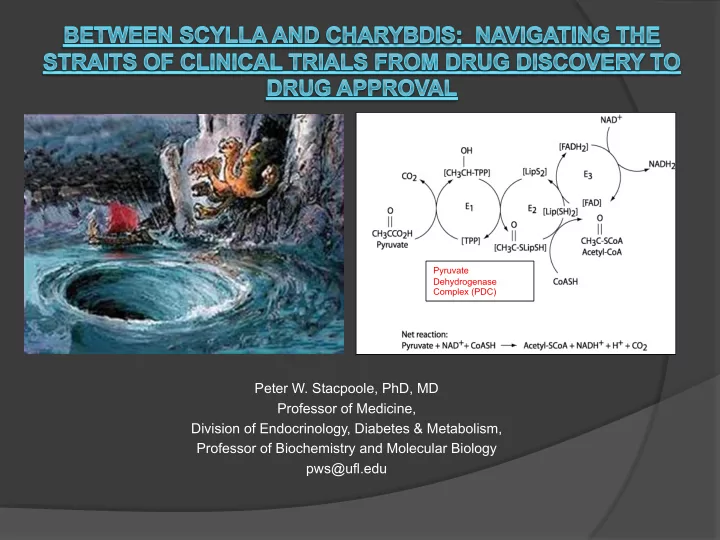

Pyruvate Dehydrogenase Complex (PDC) Peter W. Stacpoole, PhD, MD Professor of Medicine, Division of Endocrinology, Diabetes & Metabolism, Professor of Biochemistry and Molecular Biology pws@ufl.edu
Loss of function mutations in any component E1α subunit mutations > 80% of cases with molecular genetic cause • Age of clinical onset usually < 1 yr Commonest clinical signs and symptoms: Developmental delay (cognitive and milestones) • Hypotonia • Seizures • Commonest cause of congenital lactic acidosis (CLA) ↑ blood and/or CSF lactate • L/P ≤ 20 • Brain imaging Enlarged ventricles • Brain atrophy • Other structural abnormalities • Leigh syndrome (bilaterally symmetric degeneration of basal • ganglia, brain stem, cerebellum) Most patients die within months─a few years of diagnosis but a few with mild mutations live into adulthood CLA in neonatal period portends dire prognosis • Patel KP et al. Mol Gen Metab 106:385-394, 2012
In U.S., frequency of ≤ 200,000 Defined by Congress in 1983 (Orphan Products Act) • 5,000-6,000 diseases qualify ~12 M Americans affected Historically fell into “Valley of Death” Licensing, Testing, Approval Potential New Rx $
Dichloroacetate (DCA) Investigational drug (mg/kg/d) Genetic mitochondrial diseases • Others • Ubiquitous in biosphere (µg/kg/d) TCE metabolite • 10,000 fold conc. range Disinfection by-product • Fog and rain •
DCA
Diverse anecdotal evidence of benefit Alexander and Mom Next step: a clinical trial
An experiment in which the test subjects are humans. Prospective, not retrospective. Often involves a novel intervention or a novel use of an established intervention (drug, vaccine, gene, food, device). Investigational New Drug (IND) permit held by sponsor or investigator. Investigators include physicians, nurses, dieticians, laboratory technicians, biostatisticians. Common venues for rare disease trials are Academic Health Centers. There are no FDA-approved therapies for any primary mitochondrial disease.
Phase I: Drug metabolism and dose- ranging studies in healthy volunteers. Phase II:Blinded or open-label studies in the target population for safety and efficacy. Phase III: Randomized, double-blind, placebo-controlled study in target population for safety and efficacy.
Submitted to Food and Drug Administration (FDA). Requires one or more pivotal Phase III trials. Foreign studies may help, or not.
Institutional Review Board (IRB) Data Safety Monitoring Board (DSMB) FDA
43 children (5.6 yr at entry) PDCD (11); RC +/- mtDNA mutation (32) Depicted are means ± SD of venous blood lactate levels obtained 1 hour after The ratio of the proportions of concordant, the meal was consumed. discordant, and tied pairs of Global Assessment of Treatment Efficacy (GATE) ratings were used to calculate the GOR point estimates and 95% confidence intervals (CIs) for each major outcome variable. Where the 95% CI includes the value of 1, no significant difference in Stacpoole PW et al. Pediatrics 117:1519, 2006. treatment versus placebo group was observed.
Is survival in PDC improved? Kaplan-Meier plot of percentage of survival of 36 subjects. Effect of DCA on blood and CSF lactate concentrations. The red lines denote mean changes. Data from open label and controlled trials. Stacpoole PW et al. Pediatrics 121:e1233, 2008. Berendzen K, et al. Mitochondrion 6:126, 2006.
Scylla Non-patentable molecule, so Pharma uninterested • 1 st trial showed no obvious clinical benefit • Charybdis Rare disease research tough to do and fund and tougher to do • clinical trials Greener pastures elsewhere? •
The design of the trial is: Four years duration, recruiting at least 24 1. children (1 m – 18 y) Placebo-controlled 2. Double-blind 3. Crossover, followed by open label phase 4. a. Each patient is own control b. All patients receive DCA Randomized (flip of a coin) 5. Mainly parental/guardian home assessments, 6. using novel survey tool
Major effort by PDCD organization and FDA Prospectively evaluates how patient feels and functions at home Stipulated by FDA as Primary Efficacy Outcome measure, the results of which may led to drug approval Novel tool for mitochondrial diseases Daily assessment of multiple domains (e.g., Motor, Neurological, GI, General Health) Uploaded daily by recorder to Data Coordinating Center (DCC) for data management and analysis Patient clinic visits (~5) over ~10 month crossover period, then visits every 6 months during open label phase (months-years)
Recognition of conflict within rare disease professional community about RCTs Funding problems can delay trial and discourage investigators Single center study can limit FDA enthusiasm Eligible patients can be lost to logistics of travel and to competing trials Small population requires large and effective catchment net Consensus on diagnostic criteria, frustrating, humbling and educational Importance of choosing validated assessment tools Questionable applicability of key outcome measures (if available)
Evaluation of DCA in PDCD promising Multicenter study possible PDCD organization and collaborating centers Medosome Biotec interested in commercializing DCA genotyping kit Location of clinical trial sites (red) and states with PDCD families involved In ObsRO development (yellow).
1. Advocate! - Families - Caregivers - UMDF: see PDCD Landing page at www.umdf.org/pdcd - Donors 2. Participate! - Phase 3 trial 3. Benefit! - DCA is/is not safe and effective therapy - If FDA-approved, could be covered by insurance - Pioneering the first approved Rx for any primary (congenital) mitochondrial disease
PDC as therapeutic target for: 1. Diabetes 2. Heart disease 3. Pulmonary dis. 4. Cancer 5. Others ?
Questions? Comments?
Recommend
More recommend